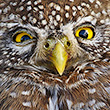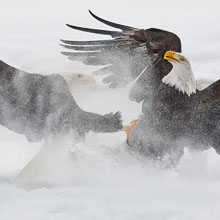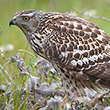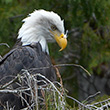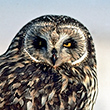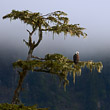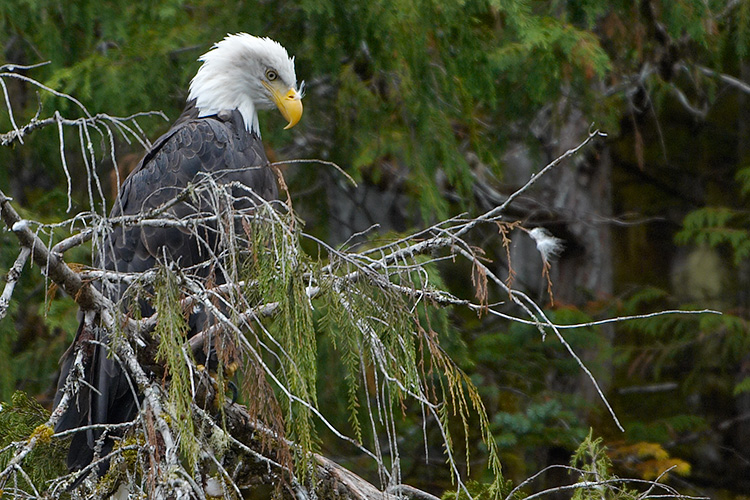
Availability: Undetermined - Enquiries?
In the Field
Bald Eagle in Great Bear Rainforest. Mussel Inlet, BC, Canada. September 12, 2005.
I like this shot. It's definitely NOT a prize-winner (present or future!) and it probably wouldn't evoke much of a reaction from others, but it evokes a strong and pleasant memory for me! But I also like it because it was technically a very tricky image to capture with a lot of hurdles to overcome.
I had to deal with 3 major challenges to deal with when shooting this image. To begin with, it was essential to isolate the eagle from the "busy" background. Given the distance between myself and the eagle (and the distance between the eagle and the background) it wasn't possible to throw the background completely out-of-focus by choosing a large aperture. But, I opened the aperture up fully and it helped a little.
The second problem was holding my camera and long telephoto lens still enough to capture a clear image - I was forced to shoot the image while hand-holding a very large lens from a moving Zodiac boat. Again, using a large aperture helped (in producing a faster shutter speed), but so did bumping up the ISO setting to 200 and using my lens's VR function on its "Active" mode.
The final hurdle to overcome was exposure - the scene was pretty much dominated by midtones, except for the snow-white head of the eagle, which is a situation where it's really easy to over-expose (or "blow-out") the highlights. In this case over-exposing the head, and losing all the white-on-white detail, woiuld have been disastrous to the image. So the solution was over-riding my camera's exposure meter (in this case by over a stop) to get the correct exposure.
And, you have 5 seconds to assess the situation and make all the right decisions! Which is definitely part of the challenge and joy of wildlife photography!
Behind the Camera
Bald Eagle in Great Bear Rainforest. Mussel Inlet, BC, Canada. September 12, 2005.
Digital Capture; Compressed RAW (NEF) format; ISO 200.
Nikon D2X with Nikon 200-400 mm f/4G ED-IF AF-S VR lens @ 400 mm (600 mm equivalent with digital conversion factor) - handheld. VR turned to "On" and in "Active" mode.
1/350s @ f4; -1.33 stop compensation from matrix-metered exposure setting.
At the Computer
Bald Eagle in Great Bear Rainforest. Mussel Inlet, BC, Canada. September 12, 2005.
Details to follow.
Conservation
Bald Eagle in Great Bear Rainforest. Mussel Inlet, BC, Canada. September 12, 2005.
Ten percent of the revenue generated by this image will be donated to Raincoast.
Species Status in Canada*: This species is not designated as at risk. The Bald Eagle was listed as "Endangered" in the contiguous US states from 1967 to 1995. In 1995 it was downlisted to "Threatened". On June 28, 2007 Bald Eagles were removed from the list of endangered and threatened species - a true American conservation success story.
The Bald Eagle (Haliaeetus leucocephalus) is a very large bird of prey with broad wings. Adults possess characteristic white ("bald") heads. It takes Bald Eagles a full five years to attain their characteristic adult plumage (including their nearly pure white head and tail). In the years prior to the development of their adult plumage they are easy to confuse with Golden Eagles. Being very broad-winged Bald Eagles are able to use an energy-efficient flapping-soaring style of flight. While many people like to think of the Bald Eagle as a fierce hunter, in reality they hunt only as a last resort. More commonly they scavenge for their prey. Additionally, they often klepto-parasitize other weaker species such as Osprey, commonly stealing the other species hard-earned prey items. The Bald Eagle is, of course, the national emblem of the United States (Benjamin Franklin argued against this - his preference was for the Wild Turkey).
This Bald Eagle was photographed in the Great Bear Rainforest on the northern BC coast. While Bald Eagles are currently not under the threat of extinction, they do, of course, require suitable breeding habitat to continue to thrive. Many ecosystems - including Bald Eagle breeding areas - within the Great Bear Rainforest are under threat, especially from the forestry industry (logging in particular). The Raincoast Conservation Society (and Foundation) is an effective and efficient organization that has been fighting for protection of this unique habitat. If you are looking for a meaningful way to contribute to the conservation of this amazing ecosystem, Raincoast will provide maximal "bang" for your conservation dollars.
*as determined by COSEWIC: The Committee on the Status of Endangered Wildlife in Canada



















